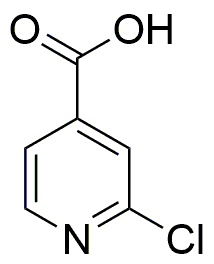2-Chloroisonicotinic acid is widely utilized in research focused on:
- Synthesis of Pharmaceuticals: This compound serves as a key intermediate in the synthesis of various pharmaceutical agents, particularly in the development of anti-inflammatory and anti-cancer drugs.
- Agricultural Chemicals: It is used in the formulation of agrochemicals, enhancing the efficacy of herbicides and pesticides, which helps in improving crop yields.
- Material Science: The compound plays a role in creating advanced materials, such as polymers and coatings, which exhibit improved durability and resistance to environmental factors.
- Biochemical Research: Researchers utilize it in studies related to enzyme inhibition and receptor binding, contributing to a better understanding of metabolic pathways and drug interactions.
- Analytical Chemistry: It is employed as a reagent in various analytical techniques, aiding in the detection and quantification of other chemical substances in complex mixtures.
Informations générales
Propriétés
Sécurité et réglementation
Applications
2-Chloroisonicotinic acid is widely utilized in research focused on:
- Synthesis of Pharmaceuticals: This compound serves as a key intermediate in the synthesis of various pharmaceutical agents, particularly in the development of anti-inflammatory and anti-cancer drugs.
- Agricultural Chemicals: It is used in the formulation of agrochemicals, enhancing the efficacy of herbicides and pesticides, which helps in improving crop yields.
- Material Science: The compound plays a role in creating advanced materials, such as polymers and coatings, which exhibit improved durability and resistance to environmental factors.
- Biochemical Research: Researchers utilize it in studies related to enzyme inhibition and receptor binding, contributing to a better understanding of metabolic pathways and drug interactions.
- Analytical Chemistry: It is employed as a reagent in various analytical techniques, aiding in the detection and quantification of other chemical substances in complex mixtures.
Documents
Fiches de données de sécurité (FDS)
La FDS fournit des informations de sécurité complètes sur la manipulation, le stockage et l’élimination du produit.
Spécifications du produit (PS)
Le PS fournit une description complète des propriétés du produit, notamment sa composition chimique, son état physique, sa pureté et les exigences de stockage. Il détaille également les plages de qualité acceptables et les applications prévues du produit.
Certificats d'analyse (COA)
Recherchez des certificats d'analyse (COA) en saisissant le numéro de lot du produit. Les numéros de lot et de lot se trouvent sur l'étiquette d'un produit, après les mots « Lot » ou « Lot de fabrication ».
Numéro de catalogue
Numéro de lot/série
Certificats d'origine (COO)
Ce certificat d'exploitation confirme le pays dans lequel le produit a été fabriqué, et détaille également les matériaux et composants utilisés et s'il est issu de sources naturelles, synthétiques ou autres sources spécifiques. Ce certificat peut être requis pour les douanes, le commerce et la conformité réglementaire.
Numéro de catalogue
Numéro de lot/série
Fiches de données de sécurité (FDS)
La FDS fournit des informations de sécurité complètes sur la manipulation, le stockage et l’élimination du produit.
DownloadSpécifications du produit (PS)
Le PS fournit une description complète des propriétés du produit, notamment sa composition chimique, son état physique, sa pureté et les exigences de stockage. Il détaille également les plages de qualité acceptables et les applications prévues du produit.
DownloadCertificats d'analyse (COA)
Recherchez des certificats d'analyse (COA) en saisissant le numéro de lot du produit. Les numéros de lot et de lot se trouvent sur l'étiquette d'un produit, après les mots « Lot » ou « Lot de fabrication ».
Numéro de catalogue
Numéro de lot/série
Certificats d'origine (COO)
Ce certificat d'exploitation confirme le pays dans lequel le produit a été fabriqué, et détaille également les matériaux et composants utilisés et s'il est issu de sources naturelles, synthétiques ou autres sources spécifiques. Ce certificat peut être requis pour les douanes, le commerce et la conformité réglementaire.


